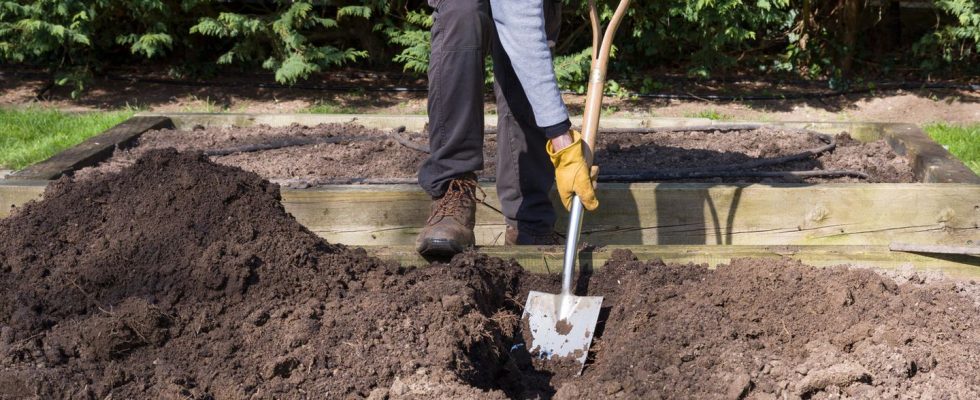Planting system
Which soil is suitable for raised beds? These four layers are crucial
The top layer in the raised bed should consist of nutrient-rich soil
© PaulMaguire/Getty Images
A raised bed has many advantages: it makes access more difficult for snails, is back-friendly and ensures a high-yield harvest – provided you use the right soil. A total of four different layers are necessary for an optimal result.
Most fruit and vegetable plants feel just as comfortable in a raised bed as they do on the ground. To ensure that plants are provided with all the nutrients they need to grow, the right soil is an important indicator. Ideally, this is made up of four different layers: The organic materials become increasingly finer from bottom to top and ensure that high-quality humus forms in the raised bed, which nourishes your plants for years to come. We have summarized for you below why this is the case and how the different layers are made up.
Fill the raised bed with soil: layer by layer
A raised bed ideally consists of four different layers. These not only provide your plants with all the important nutrients, but also with heat that is generated by the rotting process – and should therefore enable earlier sowing and a better harvest. But what are the individual layers made of? This is what you will now find out (listed from bottom to top):
- The drainagesay that base layerconsists of coarse filling material: cut twigs and branches, hedge cuttings and leaves (except from hazelnuts), stones and wood chips. Its primary purpose is to ensure that the water can drain more easily into the ground below through the cavities created in the raised bed, thus preventing waterlogging. In addition, the organic materials prevent the fine layers of earth above from sliding down. However, you should definitely avoid rose branches, ivy, thuja and coniferous wood.
- One comes over the drainage leaf layer, which is also intended to ensure that the two upper layers in the raised bed do not sag too much. It doesn’t just have to consist of leaves, but can also contain branches and grass clippings. Even green kitchen scraps can be added. If you don’t have enough filling material, you can use the appropriate one Raised bed soil Can also be purchased at hardware stores or online.
- Fresher compost is the third layer that you add to the raised bed. It supplies the plants with all vital nutrients and also generates heat. The soil may consist of coarse or fine garden and organic waste, grass clippings or straw, but should be free of fungi or pests. Alternatively, just go for high-quality ones Compost soil for raised beds – preferably in combination with Horse manureif you want to plant heavy feeders (e.g. pumpkin and zucchini).
- The fourth and last Planting layer The raised bed should be made from a peat-free bed Humus or compost soil and high-quality topsoil. It contains by far the most nutrients, as the first roots of a plant form in it, which can therefore be optimally supplied. Accordingly, the top layer in a raised bed is already so worn out after one season that it has to be refreshed the next year. You can find out more about this in the last section.
The most important tips on filling height and quantity
Depending on how big a raised bed is, different amounts of soil fit into it. Accordingly, you should adjust the four layers mentioned to the maximum filling quantity. The following information should serve as a guideline – based on a raised bed that is 75 to 80 centimeters high:
- The basic filling must not make up more than 40 percent of the raised bed, i.e. the lowest drainage should be 30 centimeters high.
- Leaves, vegetables and garden waste should make up no more than 25 percent of the raised bed, so that the leaf layer is 20 centimeters high.
- The compost layer is significantly richer in nutrients and therefore thinner than the layers of soil underneath – it should only be ten centimeters high.
- The top layer can be a little thicker, but should only be 15 centimeters high in order to adequately supply all the plants.
How to fill the raised bed next year
As already mentioned before, heavy feeders remove a large part of the nutrients from the top layer in the raised bed. In addition, it sags a little over time. Accordingly, you should refresh and fill the soil again before the next gardening season – ideally with new, peat-free soil raised bed soil (approx. 20 cm high). However, before you take this step, it may make sense to remove part of the planting layer and enrich the rest with fresh compost or horse manure.
And one more note at the end: If you cover the raised bed with grass clippings or leaves before the onset of winter, new humus soil can form through the organic filling material.
You might also be interested in:
This article contains so-called affiliate links. Further information are available here.


